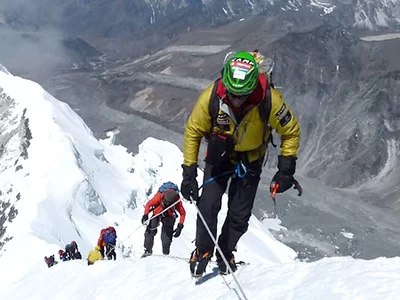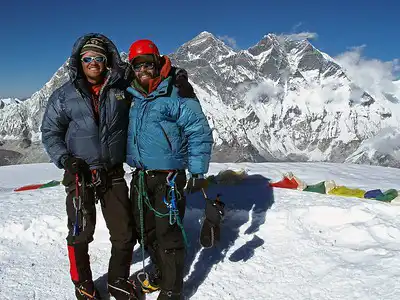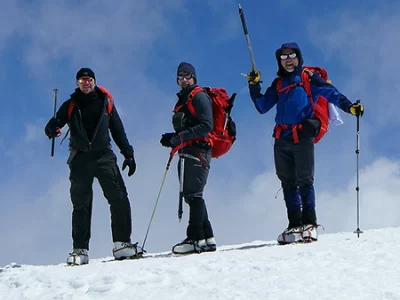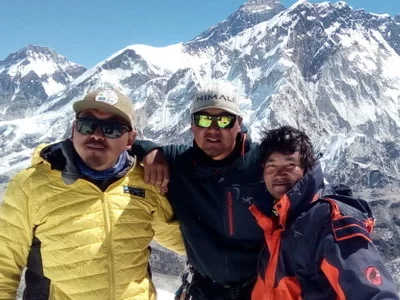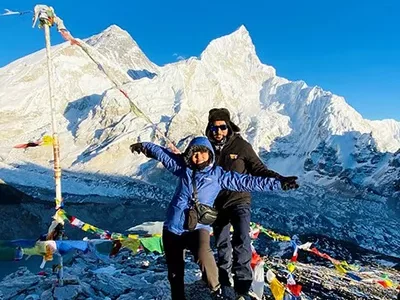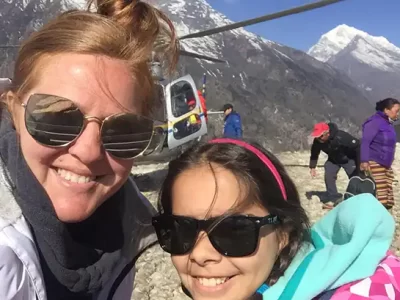Island Peak, also called Imja Tse, is a prominent climbing peak in Nepal’s Everest region. Rising to 6,189 meters (20,305 feet), it offers climbers an exhilarating experience and an introduction to high-altitude mountaineering. Island Peak Climbing from Chhukung has gained popularity because of the short approach from the village, making it an accessible choice for adventurers seeking stunning mountain scenery. This climb provides breathtaking views of Everest, Lhotse, and other towering Himalayan peaks.
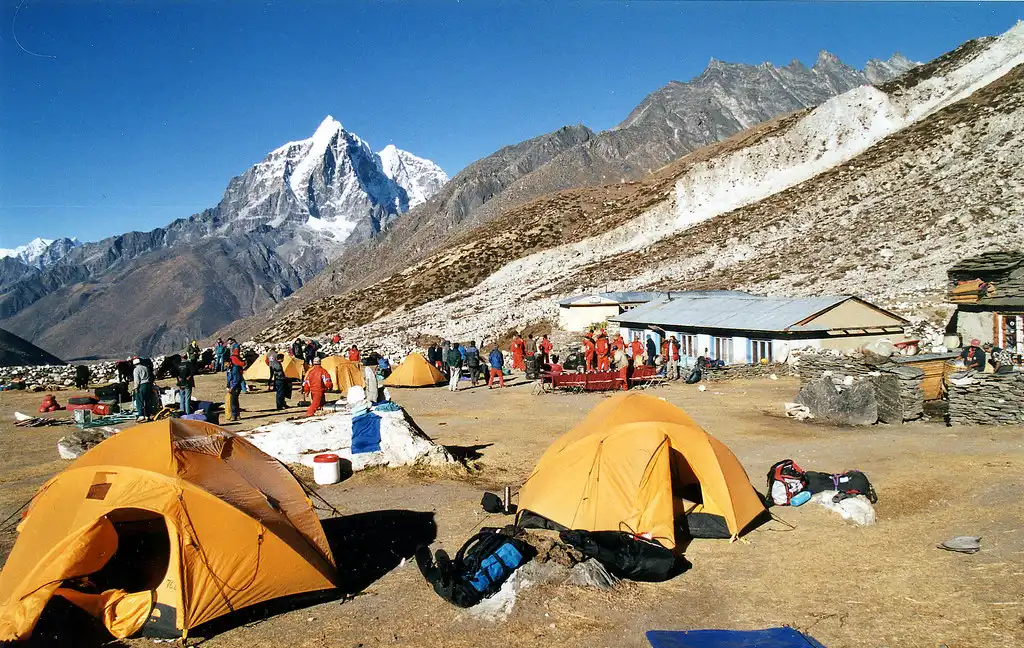
Island Peak often attracts inexperienced and very selective climbers. Trekking and specialist bolting are transparently mixed, eliciting difficulties experienced in snow-covered slopes, cracks, and glaciers. The summit presents a fantastic chance for people looking to improve their skills further in places of high elevation.
Why Chhukung Serves as the Perfect Starting Point
- Ideal for Acclimatization: Chhukung, located at 4,730 meters (15,518 feet), offers a perfect spot for climbers to acclimatize before the ascent. Staying here allows climbers to adjust to the altitude, reducing the risks of altitude sickness during the climb.
- Close Proximity to Base Camp: The Island Peak Climbing from Chhukung distance measures only around 6 kilometers (3.7 miles) to the Base Camp. This short distance helps climbers conserve energy for the challenging ascent to the summit.
- Well-Equipped Facilities: Chhukung provides various amenities, including guesthouses, equipment rental shops, and experienced guides. Climbers can rent high-quality gear and make last-minute preparations without bringing everything from Kathmandu.
- Scenic Trek: The route from Chhukung to Island Peak Base Camp offers mesmerizing views of peaks such as Lhotse and Ama Dablam. The stunning landscapes add beauty to the entire climbing experience.
Difficulty Level and Who Should Attempt Island Peak Climbing
Island Peak Climbing from Chhukung may fall under the “trekking peak” category, but it demands physical fitness and basic mountaineering skills. Here’s a detailed look at the climb’s difficulty and who can attempt it:
- Technical Aspects: Climbers must navigate glaciers, crevasses, and a steep headwall near the summit. Equipment like crampons, ropes, ice axes, and harnesses is essential, especially for the final push. Familiarity with these tools can significantly increase the chances of a successful ascent.
- Physical Fitness: Climbers should build their stamina through regular cardio and strength training. The summit push from Base Camp typically takes 8-10 hours, followed by a descent that tests both physical endurance and mental focus.
- Acclimatization: Proper acclimatization is critical in minimizing the risk of altitude sickness. Spending time in Chhukung before the climb allows the body to adjust to the high altitude. Climbers should also stay hydrated, rest adequately, and pace themselves during the ascent.
Who Can Attempt
- Experienced Trekkers: If you’ve trekked at high altitudes, like on the Everest Base Camp Trek or Annapurna Circuit, you can tackle Island Peak with the proper training and preparation.
- Novice Climbers: Beginners can attempt this climb if they undergo pre-climb training and hire an Island Peak guide. A guide provides support in technical sections and navigational assistance and ensures safety, making the climb more manageable for first-timers.
- Professional Climbers: Seasoned mountaineers often use Island Peak to practice technical skills and acclimatize for higher peaks, including Everest and Lhotse.
Island Peak Climbing with EBC Trek
Ama Dablam Expedition
Mera Peak Climbing
Route Overview: Island Peak Climbing from Chhukung
Island Peak Climbing from Chhukung offers climbers an incredible adventure in the heart of Nepal’s Khumbu region. This route challenges climbing skills while showcasing the stunning Himalayan landscape up close.
Detailed Route Description: Chhukung to Island Peak Base Camp
Starting Point: Chhukung Village
Chhukung, located at an altitude of 4,730 meters, serves as the main starting point for the climb. This village is well-equipped with guesthouses and shops where climbers can rent or purchase gear, making it a convenient and comfortable place to begin the ascent.
Trek to Island Peak Base Camp
The hike from Chhukung to Island Peak Base Camp is nearly six kilometers away and takes approximately 3 to 4 hours. It is an average-difficulty trek meant to prepare for upcoming technical parts while simultaneously acclimatizing. Initially, the terrain was friendly, but it turned rocky as you neared Base Camp.
Key Stops on the Route
Chhukung to Base Camp
- Terrain: The path from Chhukung to Base Camp starts with a relatively smooth trail, which gets rockier near the camp. The change in terrain helps climbers practice their footing on uneven ground.
- Acclimatization: Spending at least one night at Base Camp is crucial. This acclimatization period helps prepare climbers for the final summit push and reduces the risk of altitude sickness.
Base Camp to the Summit
- Ascent: From Base Camp, the climb becomes steeper and more challenging. The total Island Peak Climbing from Chhukung distance to the summit measures approximately 10 kilometers, including the demanding final stretch.
- High Camp Option: Some climbers set up a High Camp to break the summit push into more manageable sections. This option depends on individual preference, weather conditions, and energy levels.
Highlighting the Island Peak Climbing from Chhukung Distance
- Total Distance: The round-trip distance from Chhukung to the summit is around 14 kilometers. Climbers ascend from 4,730 meters at Chhukung to the summit’s 6,189 meters.
- Climbing Strategy: Most climbers prefer to complete this ascent over two days. A stop at Base Camp for acclimatization significantly increases the chances of a successful summit.
Terrain Description
Climbers must prepare for varying terrain conditions during Island Peak Climbing from Chhukung.
- Glaciers and Snowfields: The upper sections near the summit involve crossing glaciers and snowfields. Climbers must use crampons and ropes to navigate these areas safely.
- Crevasses: The glacier crossing presents the danger of hidden crevasses. A skilled Island Peak guide can help safely navigate through these treacherous sections.
- Rocky Sections: The lower part of the climb features rocky trails, which gradually transition to snow and ice as you ascend. This variation in terrain demands careful attention and proper use of climbing equipment.
Lobuche Peak Climbing
Everest Base Camp Trek
Everest Base Camp Trek with Helicopter Return
Best Time for Island Peak Climbing from Chhukung
Selecting the right season for Island Peak Climbing from Chhukung is essential for a successful and enjoyable adventure. The ideal times for this climb are spring and autumn, which provide the most favorable weather and stunning mountain views.
Ideal Seasons for Climbing Island Peak
- Spring (March to May): Spring is one of the best times for Island Peak Climbing from Chhukung. The weather remains relatively stable during these months, offering mild daytime temperatures and cooler nights. Snow conditions on the peak are also suitable for climbing, making it an excellent season for beginners and seasoned mountaineers. Additionally, the spring trek presents beautiful scenery, with blooming rhododendrons and alpine flowers enhancing the route.
- Autumn (September to November): Autumn is another preferred season for climbing Island Peak. Climbers enjoy clear, dry weather during this time, allowing for breathtaking Himalayas views. While daytime temperatures are moderate, nights can become quite chilly, especially at higher elevations. In autumn, trails remain drier and less muddy than during the monsoon season, making the trek more manageable.
Weather Conditions and How to Prepare
Weather conditions during Island Peak Climbing from Chhukung vary depending on the season. Knowing what to expect helps climbers plan for potential challenges:
- Cold Temperatures: Higher altitudes experience significant temperature drops, particularly during the early morning summit push. To stay protected against the cold, climbers should pack warm gear, including insulated jackets, thermal layers, gloves, and hats.
- Snow and Ice: Both spring and autumn feature snow and icy sections, particularly near the summit. Proper use of crampons, ropes, and ice axes is crucial in these conditions. An Island Peak guide can ensure climbers have the necessary equipment and skills for a safe ascent.
- Potential Storms: Despite the generally stable weather in spring and autumn, climbers must prepare for sudden weather changes. Strong winds, snowstorms, and freezing temperatures can occur unexpectedly at higher altitudes. Monitoring weather forecasts and following the advice of your guide can help avoid risky situations.
Physical Preparation and Training
Climbers must build a solid physical foundation to complete Island Peak Climbing from Chhukung. Because of this region’s steep and high mountains, the climb requires endurance, strength, and stamina.
Climbing at such elevations for 5-7 hours daily improves the chance of success. Those who have hiked to Everest Base Camp before will find this climb easier. On the other hand, beginners can also undertake the challenge if they are well-prepared.
Fitness Level Required for Island Peak
Climbers must be healthy enough to handle Island Peak Climbing from Chhukung. Prior trekking experience in high-altitude regions like the Annapurna Circuit gives an edge, but it’s not mandatory. With adequate preparation, beginners can still take on this climb.
Suggested Training Tips
- Altitude Training: Island Peak stands over 6,000 meters, where the air contains much less oxygen. Prepare by including altitude training in your fitness routine. Spend time trekking in high-altitude areas or use hypoxic training masks to simulate lower oxygen levels. This training allows your body to adapt to high-altitude conditions, reducing the risk of altitude sickness during the climb.
- Cardio and Stamina Building: The trek involves long hours of uphill walking and navigating rocky paths. Building cardiovascular fitness becomes crucial here. Include exercises like running, cycling, and swimming, aiming for 3-4 weekly sessions. Gradually increase the intensity to improve stamina. Hiking on inclined trails or stair climbing with a weighted backpack helps build leg strength and endurance.
- Strength Training: Strengthen your core, legs, and shoulders to meet the demands of the climb. Incorporate squats, lunges, and deadlifts to boost leg strength. Add push-ups, pull-ups, and shoulder presses to build upper body strength, which is crucial for using trekking poles and carrying gear.
- Ice Climbing Practice: The final part of Island Peak Climbing from Chhukung involves glaciers and steep ice sections. Practice using crampons and an ice axe on indoor climbing walls, or join a local mountaineering course. This training will make you feel confident and secure during the summit push.
Island Peak Guide: Why You Need One
Hiring an Island Peak guide makes the climb much safer and more successful. Even though some experienced climbers might think about going alone, having a certified guide has many benefits that are hard to ignore.
Benefits of Hiring an Island Peak Guide
- Safety: Guides ensure climbers follow the correct path and avoid dangerous areas, particularly when crossing glaciers and navigating crevasses. They receive training in first aid and rescue techniques, making their skills invaluable during emergencies.
- Navigation: The route to Island Peak can be confusing, especially in snow-covered and icy areas. An Island peak guide knows the terrain well and can efficiently navigate, saving time and energy.
- Technical Support: Climbing Island Peak requires ropes, crampons, and ice axes. A guide offers technical support and instructs you on using this equipment properly. They also set up fixed lines on steep sections to ensure a safe ascent.
What a Typical Guide Provides
- Equipment Assistance: Guides help with selecting, renting, and using equipment. They also check the condition of climbing gear, including crampons, harnesses, ropes, helmets, and ice axes, to ensure it’s suitable for the climb.
- Acclimatization Guidance: Acclimatization is essential for survival. Guides observe one’s well-being, can identify when one needs a break and can modify a plan so that one’s body can adjust to the high elevation levels. This approach minimizes the chances of altitude sickness and increases the probability of summiting.
- Route Planning and Weather Monitoring: Guides plan the route based on current weather conditions and climbers’ pace. They stay updated with weather forecasts, advising when to attempt the summit and when to hold back for safety.
Permits and Regulations for Island Peak Climbing
Before setting off on Island Peak Climbing from Chhukung, climbers must secure the necessary permits. The following are required:
Island Peak Climbing Permit
You’ll need a particular Nepal Mountaineering Association (NMA) license to climb Island Peak. It’s a must-have for anyone taking on this challenge. The cost of this permit varies depending on the season:
- Spring (March to May): $250 per person
- Autumn (September to November): $125 per person
- Winter and Summer (December to February, June to August): $70 per person
Sagarmatha National Park Entry Permit
- Since Island Peak Climbing from Chhukung takes place within Sagarmatha National Park, all climbers must obtain an entry permit. This permit costs NPR 3,000 (approximately $30) for foreigners. Climbers can acquire this permit in Kathmandu or at the park’s entrance in Monjo.
Khumbu Pasang Lhamu Rural Municipality Permit
- Besides the national park entrance fee, climbers must also pay a local fee for the Khumbu region. You can obtain this permit in Lukla for NPR 2,000 (about $20).
Additional Fees and Paperwork for International Trekkers
- TIMS Card (Trekkers’ Information Management System): While a TIMS card is generally required for most treks in Nepal, those trekking in the Everest region, including Island Peak Climbing from Chhukung, do not need it as long as they have the Sagarmatha National Park entry permit and the local Khumbu permit.
- Travel Insurance: Although not a government requirement, travel insurance is essential for all international trekkers. The insurance should cover high-altitude climbing (up to 6,500 meters), emergency evacuation, and medical expenses.
Accommodation and Food on the Route
Planning where to stay and how to manage meals is crucial for a successful Island Peak Climbing from Chhukung. Options vary depending on the altitude and the level of comfort sought.
Accommodation Options
- Lodges in Chhukung: Chhukung offers several lodges and teahouses where climbers can rest before starting their ascent. These lodges provide basic amenities, including beds with blankets and access to a shared bathroom. Staying in Chhukung helps acclimatize before moving to higher altitudes.
- Tents at Base Camp: Accommodation at Island Peak Base Camp typically involves camping in tents. Most climbers set up tents here through a guided expedition or renting equipment in Chhukung. If hiring an Island Peak guide, the company often includes tents, sleeping bags, and other necessary camping gear in their package.
Food Options on the Route
- Meals in Lodges (Chhukung): In Chhukung, lodges serve various meals, including traditional Nepali dishes like dal bhat, soups, noodles, and pasta. Breakfast options typically include porridge, eggs, bread, and tea. The food here is simple yet nutritious, helping climbers replenish energy.
- Meals at Base Camp: At higher altitudes, food options become more limited. Most climbers bring their food supplies for Base Camp, including high-energy snacks like nuts, dried fruits, energy bars, and instant noodles. If you have hired an Island peak guide, they often prepare meals at Base Camp, providing hot drinks and easy-to-cook meals to keep you fueled for the climb.
Island Peak Climbing from Chhukung: Essential Gear, Equipment
Proper gear is crucial for a successful Island Peak Climbing from the Chhukung experience. This climb involves navigating steep snowfields, ice walls, and rocky sections. Here’s a detailed list of the equipment you need and the challenges you might face.
Essential Climbing Equipment
- Ice Axe: It would be best to have an ice axe to ascend steep snow and ice sections. It offers stability on icy slopes, especially during the summit push.
- Crampons: Crampons attach to your climbing boots, providing traction on ice and snow-covered surfaces. Please make sure they are compatible with your shoes for a secure fit.
- Climbing Helmet: Wear a helmet outdoors to avoid falling rocks, ice, or equipment accidents. Choose a light, adjustable helmet that fits well to ensure comfort throughout your climbing experience.
- Ropes: Ropes are necessary for crossing crevasses and scaling steep sections. If you hire an Island Peak guide, they typically bring the required ropes and manage their usage.
- Harness: A harness connects you to the ropes for safety on steep slopes. It should fit snugly and be comfortable enough for extended wear.
Clothing and High-Altitude Gear
- Insulated Jacket: An insulated jacket, either down or synthetic, keeps you warm in freezing temperatures, especially during early morning summit attempts.
- Base Layers: Opt for moisture-wicking thermal tops and bottoms. They help regulate body temperature and keep you dry in extreme conditions.
- Waterproof Outer Shell: Wear a waterproof, windproof jacket and pants to shield yourself from snow, wind, and unexpected weather changes.
- Climbing Boots: Invest in high-quality, insulated climbing boots compatible with crampons. These boots provide warmth and stability on icy terrain.
- Gloves and Mittens: Carry several pairs, including lightweight gloves for climbing and heavy, insulated mittens for summit day.
- Hat and Buff: A warm hat and a buff protect you from cold winds and help retain body heat at high altitudes.
Additional Equipment
- Sunglasses and Goggles: UV-protective sunglasses are essential to prevent snow blindness. Pack goggles for windy or snowy conditions.
- Headlamp: A headlamp is necessary for early morning starts and low-light conditions. Always bring extra batteries.
- Backpack: A lightweight, durable backpack (30-40 liters) that carries essentials like water, snacks, and extra layers.
- Sleeping Bag: A high-altitude sleeping bag rated for -20°C or lower ensures warmth and comfort at Base Camp.
Renting or Buying Equipment
Quality gear is non-negotiable for Island Peak Climbing from Chhukung. If you already own it, inspect it thoroughly. Renting high-quality gear is an excellent option if you prefer not to buy. Equipment rental shops in Chhukung and Kathmandu offer everything from climbing boots to helmets. Ensure that any rented gear fits properly and is in excellent condition.
Challenges and Risks
Island Peak Climbing from Chhukung presents several challenges. Knowing these risks and how to tackle them enhances safety and success.
Altitude Sickness
- Risk: The climb takes you above 6,000 meters, where oxygen levels drop significantly. This height increases the risk of altitude sickness.
- Safety Tips: Ascend gradually and take regular acclimatization breaks to let your body adjust. Stay hydrated and eat nutritious meals. Hiring an Island peak guide helps as they monitor your condition and suggest proper acclimatization strategies.
Crevasses and Glacier Crossings
- Risk: Glaciers hide crevasses that can be dangerous to cross. The final ascent involves icy sections that require technical skills.
- Safety Tips: Always use ropes and wear a harness while crossing glaciers. Follow your Island Peak guide closely; they know the safest paths and techniques for navigating these sections.
Weather Risks
- Risk: Weather at high altitudes changes rapidly, leading to snowstorms, high winds, and freezing temperatures.
- Safety Tips: Check weather forecasts frequently and be ready for sudden changes. Carry clothing that can protect against cold and wet conditions. Your guide will usually have up-to-date weather information and can advise on the best time to attempt the summit.
Physical Exhaustion
- Risk: The ascent involves long hours of strenuous activity, including steep climbs and navigating challenging terrain. Fatigue affects decision-making and safety.
- Safety Tips: Build endurance through pre-climb training focused on cardiovascular fitness and strength. Take regular rest breaks and maintain a steady pace. High-energy snacks like nuts and dried fruits can help maintain energy levels during the climb.
Conclusion: Why Island Peak Climbing from Chhukung is a Rewarding Experience
Completing Island Peak Climbing from Chhukung is a remarkable achievement for any climber. Standing 6,189 meters, Island Peak offers a unique blend of physical challenge, technical climbing, and breathtaking scenery. Reaching the summit provides an overwhelming sense of accomplishment, rewarding your hard work and preparation with stunning views of the Himalayas, including Lhotse, Nuptse, and even the majestic Mount Everest.
This climb goes beyond just a physical feat; it tests your endurance, mental strength, and adaptability to high-altitude conditions. Successfully conquering the Island Peak climbing from Chhukung distance reflects your dedication and perseverance. It also gives you invaluable mountaineering experience, paving the way for future high-altitude climbs. The trek from Chhukung to the summit is full of awe-inspiring moments that make every step worthwhile.
The path to the top requires careful preparation and planning. Carefully training your body and mind for high-altitude challenges is essential. Equipping yourself with the right gear and understanding the risks are equally important. Hiring an experienced Island peak guide can significantly enhance your safety and overall experience. Guides provide crucial support, from navigating treacherous glaciers to assisting with acclimatization, increasing your chances of reaching the summit safely.

